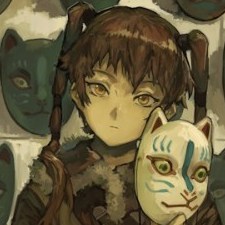All Activity
- Today
-

Latest One Piece Manga Dicussion [Spoilers]
Predaking-117 replied to spidey5443's topic in Manga/Comics
Sanji is annoyed he doesn't have Conqueror's Haki but Zoro does. Luffy and Gaban give Zoro some grief for not knowing or controlling it. Then Luffy asks Loki to join the crew, but of course he rejects. And now it's flashback time as to reveal what really happened 14 years ago in Elbaph. But before that, a backstory on Harald and how he made the world afraid of Giants because he went pillaging unopposed. Harald was childhood friends with Dorry and Brogy, and because of his bloodline and noble status was quite a narcissist. Then one day in the New World he met Ida, who was living relatively with humans and making a decent living until Harald came along. Ida knocked some sense and humility into Harald and they eventually hooked up and traveled together. And that changed him to want to build bridges with other races. But after Hajrudin was born, Harald and Ida couldn't marry in order to keep the royal bloodline pure. So instead Harald was betrothed to Estrid, a daughter of a brewer. They got a horse with 8 legs for good luck, among other trinkets to increase luck (or just Estrid wanting more fortune). And when Loki was born, he was thrown into the frozen wilds to die due to Estrid only seeing a demon. All misfortunes that fell on Elbaph in the years that followed were categorized as part of Loki's curse. - Yesterday
-
.thumb.gif.12439f167732dc046d67d3a8d5fe31e6.gif)
Final Fantasy IX (09) (2000; PC, PS1, PS3, PS4, PSP, VITA, Switch, XBONE)
Dave55811 replied to Koby's topic in Gaming Realm
Hmm. The only thing I can say in regards to FF9 is that I ordered a copy online way back. I think I was prodded into doing it. It's got the Greatest Hits label on it, meaning that I can expect the discs to not look fancy....not that I know, because I haven't opened it yet, and I was kind of hoping to not open it, but maybe preserve it as a collectible. Otherwise, FF9 was the subsequent FF game that I wasn't able to get into. I didn't even rent it like I did with FF8 back in 1999. Perhaps the one thing that discouraged me was how they went back to their characters looking "cartoony", instead of realistic like in FF8 and FF7. But, personally, the New Millennium was an event when a lot of things transpired, most of which I won't go into. Oh, and some of the media I'm seeing in this thread looks familiar. I think I was shown a side-by-side comparison between Squeenix's remaster, and an AI's remaster, and that the AI did a much better job. At the time, that struck me as how these big-ass companies are too damned lazy, and that an AI program is able to do it better. Squeenix's attempt at remastering the visuals looks sloppy, basically.....or, was it FF9 that was compared? Either way, it's amazing how these companies, which we trust with beloved IP's and franchises we grew up with, always fuck things up in the end. I hate to sound like a Negative Nancy or something, but that is my honest opinion of what has become of these companies, that they don't even seem to care about their IP's. I don't know what is causing it, besides maybe it being a consequence of videogames becoming mainstream and the expectation of the "modern audience", but whatever convoluted explanation we come up with could just go back to good old-fashioned greed, too. I don't know. -
https://store.steampowered.com/app/1356040/Ampersat/ Ampersat is currently free on Steam.
-
Fact of the Day - GREAT WHITE SHARK Did you know... The white belly of a great white shark serves a surprisingly useful purpose. Even if you’ve never had the dangerous experience of encountering a great white up close, you likely recognize the shark from movies like Jaws (1975) and Finding Nemo (2003). The predator is known for its menacing dorsal fin, rows of serrated teeth, and glassy black eyes. Their namesake white bellies are also part of their iconic look. Besides being distinctive, what purpose does the shading serve? The evolutionary advantage of the great white shark’s pale underside come down to camouflage. If you were to look up from beneath the fish—a terrifying image that’s necessary for this explanation—you’d notice that it blends in with the sunlight on the water’s surface. Similarly, a great white sports a dark gray upper body because it matches the darkness of the sea when viewed from above. This coloring is called countershading, and it allows the shark to blend in with its surroundings, hiding in plain sight from both prey and predators. Other marine animals with such coloring include penguins, whales, dolphins, and many fish. While great whites occupy the top of the food chain, they’re not totally without predators. There have been reports of orcas hunting the fish. One weakness of great whites is their tendency to enter a state of tonic immobility, characterized by inertness and semi-consciousness, when flipped upside down. Some killer whales are apparently aware of this and use it to their advantage when hunting great whites. One onlooker even caught the hunting tactic on camera in 1997, when an orca dragged a stunned shark around before eating just its liver. Great white shark livers are rich in fat and nutrients, making them a tasty treat and high-value food source for orcas. Smaller great whites also have to worry about becoming food for their larger counterparts. However, the number-one predator of these fish is humans. Shark fishing, accidental ship crashes, and getting caught as bycatch in fishing nets are some of the greatest threats facing the species. Here’s another big question concerning great whites: Why aren’t they usually found in aquariums? It turns out that they just aren’t suited for living within glass walls. You can read more about it here. Source: Why Do Great White Sharks Have White Bellies?
-
What's the Word: PAROL pronunciation: [pə-ROL] Part of speech: adjective Origin: Old French, 15th century Meaning: 1. Given or expressed orally. 2. (Of a document) Agreed orally, or in writing but not under seal. Examples: "The witness gave her evidence parol, and a stenographer took notes." "We had used Charlie the roofer before, so we hired him parol, or without a written agreement." About Parol “Parol” is borrowed from the Old French “parole,” meaning “spoken words.” (In modern French, the plural “paroles” refers to song lyrics.) Both are based on the Latin “parabola,” which is the basis for the English term “parable,” an allegorical tale. Did you Know? In English, “parole” refers to the release of a prisoner temporarily, or on promise of good behavior. These arrangements are now recorded in writing, but the Old French root “parole” literally means “word.” Dropping the “e,” “parol” is used in the legal context to distinguish information delivered orally rather than in sealed, official writing.
-

Final Fantasy IX (09) (2000; PC, PS1, PS3, PS4, PSP, VITA, Switch, XBONE)
Zemekis replied to Koby's topic in Gaming Realm
I did read your post back when you first wrote it @Koby, I have no clue why I never replied to it. I feel very similarly on nearly all points, other than preferring FF4 to 9...but I'm not disagreeing. I just haven't completed that one yet! Who knows? Tetra Master sucks, sorry to say. It can't hold a candle to Triple Triad (nor can Queen's Blood, for that matter). The ending is rushed, too. Yes despite those flaws they are primarily blemishes on what is otherwise a 9.5/10 JRPG, and a top 5 video game for me personally. So cozy and I grew up with it. There is a lot of subjective boosting going on in the game's score for sure and I don't intend to fix that. That isn't why I'm here today, however. I want to make a post prior to the 25th Anniversary. A hope & cope post regarding a possible remake. I'm guessing anyone that's in deep enough to be reading this is already familiar with the Nvidia leak from a few years back, and perhaps some of the years-long speculation regarding an FF9 remake. With the 25th Anniversary only days away (5 days at the time of writing) it is dominating discussion in my circles right now. I'm not sure if I buy it...I was 100% sold on YouTube videos and forum posts 2 years ago, then I built up excitement again maybe 16 months ago, and I quite heavily expected to see it at this year's Summer Game Fest, still nothing. Now I don't expect it on July 7th, but I'm willing to be surprised. With the announcement of the FF Tactics rerelease just weeks ago, it feels too soon. Much like with FF8 (my personal favorite) I'm not sure that I would even want a modern take on FF9 if it wasn't highly respectful of the original. A single change in the wrong direction would send me on a gatekeeping & purity spiral until I hate the remake. Action combat? No. Changes for a "modern audience?" No. Changes to the story? No. If I'm going to be so picky, why support a remake? It's really a double edged sword for me. I'm beyond curious to see what it could be, and I always have the option of retreating to my many copies of the 2000 release. My confirmation bias is that there have been too many hints for it not to be in the works. Prior to the Nvidia leak, we already knew that FF9 was the favorite among development staff & internally the one they most want to revisit. That spans both old & new staff; the old ones who worked on it & the younger guys who grew up with it. Then there's the Nvidia leak itself...no need to explain further. Then there were those interviews conducted around the office with lots of cheeky references to FF9. The animated nothingburger series (not sure what to make of that). And finally we have FF9 characters showing up in multiple mobile/gacha games, new character art from Toshiyuki Itahana. It's not quite enough to guarantee a remake but just enough to make me think it must be something. They didn't do even 1/10th of this for FF8. I know I'm coping, thinking that Squeenix won't make the worst moves possible and tease nothing. I also understand that even if they do a remake, chances are that I'll hate on it. I'm still invested in seeing where this goes. -
Watched through Erased with @Dave55811 and @Starwind55. I had seen it before, but I think it was Dave's first watch. Holds up better than expected, I actually liked it better than my 1st viewing which is rare. We also wrapped up InuYasha at some point early this year + The Legend of Heroes: Trails of Cold Steel – Northern War. That one was average at best, very low budget at times. It's sort of necessary backstory for Cold Steel III, but not as important as I'd hoped.
-
Was gonna give Takopi's Original Sin and The Summer Hikaru Died a try, blurbs seemed interesting. Now that you mention Lord of Mysteries it has pretty good preliminary reviews so maybe that too.
- Last week
-
Ermm... Lord of Mysteries, kaijuu no.8 s2 and Call of the night s2 You got any planned ?
-
Fact of the Day - ICEBERG LETTUCE Did you know..... Theories abound as to why we named our most reliably bland greens after icy formations. Film director John Waters once dubbed iceberg lettuce “the polyester of greens.” It’s not difficult to understand why: Crisp but bland and lacking the same nutritional profile as other vegetables, iceberg lettuce is often regarded as a last resort for salads. It’s probably better tolerated in hamburgers or BLTs. Only a wedge salad, where the head is left partially intact, seems to be welcome in fine dining establishments. But let’s table the debate over its merits for a moment. Why is it known as iceberg lettuce? Tip of the Iceberg According to the culinary magazine Saveur, the modern branding of iceberg lettuce was the work of W. Atlee Burpee & Co., a Philadelphia-based seed distributor, in the 1890s. The vegetable belongs to a family of lettuces known as “crisphead,” derived from Batavia lettuce, which was a similarly bulbous and leafy variety. But iceberg was crispier, had more leaves, and sported a durable outer “shell.” A sturdy ball of lettuce was surprisingly valuable. Most lettuce grown in the United States originated in California, and from there it was shipped via railroad to other parts of the country. Taste wasn't necessarily a priority: A lettuce head that could simply survive the trip was paramount. Iceberg had tough leaves that refused to wilt easily, especially when compared to other soggy, frail greens that went bad more quickly. It was also available year-round. The result? A seemingly exotic vegetable. “California iceberg lettuce,” one 1891 newspaper ad that ran in Wisconsin read. It cost 12 cents per head. Traveling well is where the origins of the name iceberg may have come from, though that’s somewhat in dispute. One theory has it that iceberg was so named because it was shipped on mounds of ice, a necessary cooling procedure before refrigerated transport became commonplace. But that may be apocryphal. Helen Rosner, a New Yorker contributor and iceberg apologist, bluntly assessed this as “pure American horsesh*t,” a tall tale spun for publicity purposes by Depression-era farmers. In speaking with Saveur, Burpee CEO George Ball offered another explanation: Iceberg refers to the white(ish) color of the outer leaves and its crunchy texture, not the ice it was packed in. That’s bolstered by some of the early descriptions of the lettuce. In an 1895 ad for iceberg lettuce seeds, Cole’s Seed Store of Pella, Iowa, wrote: “ … [the leaves] have small indents, which are constantly filled with dew-drops. They are thus kept fresh, and show a remarkably crystalline appearance, which well warrants the name of iceberg.” Further refinements to the lettuce were made, and by the 1940s, lettuce science had improved to the point where one type of crisphead was cross-bred with another variety, dubbed brittle-ice, to create the super-crisp iceberg we’re familiar with. Because it was easy to ship and slow to wilt, iceberg became the predominant type of lettuce consumed by Americans for decades. Breaking the Ice Trouble came in the form of the growing influence of celebrity chefs like Julia Child in the 1960s, who shirked iceberg for more flavorful greens like romaine and arugula. Later, the emergence of pre-bagged salad mixes that kept fresher for longer made room for other types of lettuce to get a seat at the table. Coupled with an increasingly health-conscious society, iceberg was unseated as the only lettuce game in town. Does iceberg deserve the bad rap? By some estimates, it does have a lower nutritional profile—perhaps as little as 5 percent of what other greens pack in. But for people who want to add some crunch to a salad or sandwich, that may not matter. Some even choose to grill or pickle the leaves, though that may defeat iceberg’s true purpose: to remain reliably bland, the polyester of greens. Source: Why Is It Called “Iceberg” Lettuce?
-
https://store.onstove.com/en/games/4621 Gunbird 2 is currently free on Stove. https://store.steampowered.com/app/3448320/Altar/ Altar is turning into a paid game soon. https://freebies.indiegala.com/death-goat Death Goat is currently free on IndieGala. https://freebies.indiegala.com/memetown-usa Memetown USA is currently free on IndieGala.
-
What's the Word: COPYBOOK pronunciation: [KA-pee-book] Part of speech: adjective Origin: Old French and Old English, date unknown Meaning: 1. Exactly in accordance with established criteria; perfect. 2. Tritely conventional. Examples: "Tony did a copybook landing in the flight simulator." "Trina spoke in copybook inspirational quotes." About Copybook “Copy” comes from the Old French “copier” and directly from the Medieval Latin “copiare,” meaning “to transcribe.” “Book” stems from the Old English “boc,” meaning “book, writing, written document.” Did you Know? While the adjective means “exactly perfect,” the noun form describes an old-fashioned book of handwriting to learn from. Good penmanship was considered a key business skill in the 18th century, so copybooks of the time were often geared toward those wishing to learn business skills. They included chapters on accounting and business management. Students also learned from geography copybooks, where they were asked to copy names onto unlabeled maps, and then copy entire maps onto a latitude/longitude grid.
-
Fair enough. Plan on watching anything new this season?
-
Well who knows what they will do next but ill also watch it regardless
-
Fact of the Day - CACTUS Did you know..... There are nearly 2,000 known species of cacti, all of which are native to the Americas alone — except for one. That would be Rhipsalis baccifera, also known as the spaghetti cactus or the mistletoe cactus, which grows wild in India, Sri Lanka, and Africa as well as parts of the Americas. Even stranger than the idea of a single cactus species thousands of miles away from its prickly relatives is the fact that scientists aren’t exactly sure how R. baccifera ended up in the Eastern Hemisphere to begin with. The epiphytes (also called air plants) are remarkably resilient, able to survive without soil by drawing moisture from the air, and the many theories attempting to explain their broad distribution fit their strange nature. One explanation is that birds snacked on the white berries containing R. baccifera’s seeds somewhere in South America before flying all the way to Africa, where they passed those seeds and essentially planted the cactus on the other side of the world. Problem is, scientists don’t know of any berry-snacking birds that could have actually made that journey. Another theory suggests that sailors used the cactus, with its fetching long green branches, to decorate their living quarters while journeying across the Atlantic from Brazil, then left them behind upon arriving in Africa. Yet another theory posits that the plant could have existed way back when Africa and the Americas were part of one supercontinent called Gondwana — which then broke up around 184 million years ago, leaving a little cactus on both sides. However, it’s unlikely the plant existed all those years ago. The truth is, we’ll probably just have to embrace the mystery of it all. Prickly pears are a common ingredient in Mexican cuisine. Known as the prickly pear in English, these species of Opuntia cactus are more commonly called nopales in Spanish. Rich in antioxidants and fiber, the cactus paddles — with needles removed, of course — are a key ingredient in a number of Mexican dishes. Nopales con huevos, or scrambled eggs with nopales, are a favorite, as are salads and tacos featuring them; sometimes nopales are simply eaten as a side vegetable. With a taste that’s been described as a cross between green beans and asparagus (pears and watermelons have also been mentioned as points of reference), they’re enjoyed for their versatility and nutritional value alike. They can even be added to margaritas. Source: There’s only one species of cactus found wild outside the Americas.
-
What's the Word: PARURE pronunciation: [pə-ROOR] Part of speech: noun Origin: Latin, early 17th century Meaning: 1. A set of jewels intended to be worn together. Examples: "The Spanish royal family has an impressive collection of parures." "Sophie’s great-grandmother passed down her prized parures in her will." About Parure This word stems from the Old French “pareure,” meaning “ornament.” It originates from “parer,” which means “to prepare, adorn.” Did you Know? A full parure usually includes a ring, earrings, a bracelet, a necklace, and a brooch. However, they can be quite elaborate and also include tiaras, diadems, aigrettes, and more. A demi-parure is a less elaborate jewelry suite of only two or three pieces. Parures became fashionable among the French upper class in the late 17th century, when evening salons became popular and jewels were worn with formal dress to signify prestige.
-
Fact of the Day - TOMATOES Did you know... We humans have somewhere between 20,000 and 25,000 genes — a sizable number to be sure, but still considerably fewer than the 31,760 in everyone’s favorite nightshade. Though scientists still aren’t sure why tomatoes have such a complex genome, an emerging theory relates to the extinction of the dinosaurs. Around the time those giant creatures disappeared from Earth, the nightshade family (solanaceae) tripled its number of genes. Eventually the superfluous copies of genes that served no biological purpose disappeared, but that still left a lot of functional ones; some believe the extra DNA helped tomatoes survive during an especially perilous time on the planet, when it was likely still recovering from the aftereffects of a devastating asteroid. Humans, meanwhile, have two copies of every gene: one from their mother and one from their father. The number of genes doesn’t necessarily imply biological sophistication, but rather how an organism “manages its cells’ affairs” — simply put, humans make more efficient use of the genes they have. The Human Genome Project, which launched in 1990 and took 13 years to complete, successfully mapped and sequenced every single gene found in Homo sapiens. With thousands of scientists involved, it remains the largest international collaboration ever undertaken in the field of biology — until the Tomato Genome Project is launched, that is. People used to think tomatoes were poisonous. The humble tomato used to have a far more sinister moniker: “poison apple.” In the 18th century, many believed that European aristocrats were falling ill and even dying after eating tomatoes — a misconception stemming from the use of pewter plates, which contained high lead content. Tomatoes, which are highly acidic, would leach that lead and then poison the unlucky eater. The fear of tomatoes was just as prevalent across the pond, where some American farmers believed that the green tomato worm was “poisonous as a rattlesnake.” An entomologist eventually set the record straight, and by the late 1800s more people began to appreciate tomatoes for the nutritious treat they are. Source: Tomatoes have more genes than humans.
-
What's the Word: FASCICLE pronunciation: [FAS-ə-kəl] Part of speech: noun Origin: Latin, 15th century Meaning: 1. A separately published installment of a book or other printed work. 2. (Anatomy and biology) A bundle of structures, such as nerve or muscle fibers or conducting vessels in plants. Examples: "Mae wanted to study how different groups of fascicles in mammals function." "‘Great Expectations’ was originally published as sequential fascicles in a literary magazine." About Fascicle This word stems from the Latin “fasciculus,” the diminutive of “fascis,” meaning “bundle.” Did you Know? Charles Dickens started the serialized fascicle trend when he published “The Pickwick Papers” in 20 parts between 1836 and 1837. Soon, other Victorian-era novelists began following suit. In England, these part-issue installments cost a shilling, making fiction affordable to an entirely new class of readers for the first time.
-
Fact of the Day - DOGS ON THE 4TH OF JULY Did you know.... Fourth of July fireworks and parties can be distressing for dogs—and their pet parents. Here are tips to make it easier. The Fourth of July can be rough for dogs. Fireworks displays light up their senses with unfamiliar noises, flashes, and smells, and parties flood their homes with strange guests who may invade the rooms they usually have as private retreats. And when distressed dogs escape, howl, or thrash around the house, Independence Day can quickly become a nightmare for their owners, too. To minimize Fido’s stress this holiday, we spoke to some dog experts to discover the best ways to keep your canine calm on the Fourth of July. Exercise Your Dog Anthony Newman, the dog whisperer and canine behavior expert who runs New York City’s Calm Energy Dog Training, says exercise is a great way to help your dog let off some nervous energy. “Whenever Fido is going to be neglected for an extended period of time, or around any stressful stimuli, it always helps to tire him out just before—and even during the night if you can,” Newman told Mental Floss in 2017. “As the saying goes, a tired dog is a good dog! He’ll be calmer, happier, and more peaceful.” Keep Your Dog Indoors Dr. Stephanie Liff, head veterinarian and co-owner of Pure Paws Veterinary Care in New York City, says the best place to keep your pet during a fireworks show is inside and away from the windows. “If the pet is very scared, an escape-proof crate or a sound-insulated room, such as an internal bathroom, may help the pet to feel more secure,” Liff told Mental Floss in 2017. “If you cannot keep your pet inside, make sure that the pet is prevented from escape (monitor all exits and tell guests to monitor your pet).” Socialize Your Dog While your dog may feel more secure in a room away from all the noise, Newman points out that keeping your dog isolated in another room for too long can be stressful for your pet. “Release his curiosity and let him in on the fun, to run around and play with two-legged as well as four-legged guests,” Newman said. “Then back to his obedient room, bed, car, crate, or spot. Rinse and repeat as needed throughout the night.” Take Control of Your Dog According to Newman, the best way to keep your dog calm during the chaos of July 4th is to stay in charge. “If your dog winces, shivers, and runs away at loud noises, the last thing he wants is to feel like nobody else is looking out for him,” Newman said. Don’t let your dog run rampant around the house or follow him around trying to soothe him. Instead, Newman says it’s important to “take control by attaching a super-light leash that you can grab and lead him whenever you need.” Consider Medication for Your Dog For extreme cases of nervousness, Liff said that you should talk to your vet about medication to sedate your dog. Just make sure you contact your vet well in advance of the Fourth of July festivities so you have time to pick up any medication they prescribe. Source: Ways to Keep Your Dog Calm This Fourth of July, According to Experts
-
What's the Word: VERSANT pronunciation: [VER-sənt] Part of speech: noun Origin: French, mid-19th century Meaning: 1. A region of land sloping in one general direction. Examples: "The topography on the western versant of the mountain is flatter than that on the eastern one." "The Appalachian Mountains’ versant runs toward the Atlantic Ocean." About Versant This word comes from French. It is the present participle (used as a noun) of “verser,” which means “tilt over.” It originates from the Latin “versare.” Did you Know? “Versant” can also be used as an adjective that means “conversant, experienced, or practiced.” The first known usage of “versant” as an adjective was in the mid-17th century. In fact, Merriam-Webster’s online dictionary only contains this definition for the word.
-
I think it would probably be for the best if they just put Code Geass to rest considering where it's going... That being said, I'll probably still try any new series they put out.
-
https://store.steampowered.com/app/624690/NEXT_JUMP_Shmup_Tactics/ NEXT JUMP: Shmup Tactics is currently free on Steam.
-
Fact of the Day - 20% COVERED Did you know.... It’s easy to think of major cities such as London and New York as sprawling grids of concrete, brick, and metal — but it may surprise you to learn that both cities also maintain roughly 20% tree canopy cover. That’s an urban forest of more than 8.4 million trees across Greater London and approximately 7 million trees in New York City. While other major cities have even higher tree canopy coverage — including Oslo at ~72%, Atlanta at ~50%, and Singapore at ~29% — what sets London and New York apart is the amount of greenery they contain given their massive size, population density, and global urban footprint. The London plane, a hybrid tree that received its name from its ability to withstand the city’s air pollution during the Industrial Revolution, is the most common street tree in both London and New York City. Other widely planted species include sycamore, oak, and silver birch in London and littleleaf linden, Norway maple, and green ash in NYC. These urban trees aren’t just decorative. They reduce air pollution, lower urban temperatures, and absorb stormwater that would otherwise flood drains. In New York alone, trees remove around 1,100 tons of air pollution each year and intercept more than 890 million gallons of stormwater, easing pressure on the city’s infrastructure. Greater London’s trees provide around £132.7 million worth of ecosystem services annually, which include air purification, temperature regulation, building energy savings, and rainwater interception. And of course, tree cover also supports and shelters city wildlife. So while their skylines may steal the spotlight, it’s the tree canopy that quietly keeps these cities cooler, cleaner, and more inviting. Tree Preservation Orders have been protecting U.K. trees since 1947. Introduced under the Town and Country Planning Act 1947, Tree Preservation Orders (TPOs) give local authorities in the U.K. the power to legally protect specific trees, groups of trees, or woodlands if their removal would negatively impact the local environment or public enjoyment. TPOs make it an offense to cut down, top, lop, uproot, or willfully damage a protected tree without permission. Today, thousands of trees across London are safeguarded by TPOs, ensuring the city’s urban forest continues to thrive for generations to come. Source: London and New York are each around 20% covered by trees.



